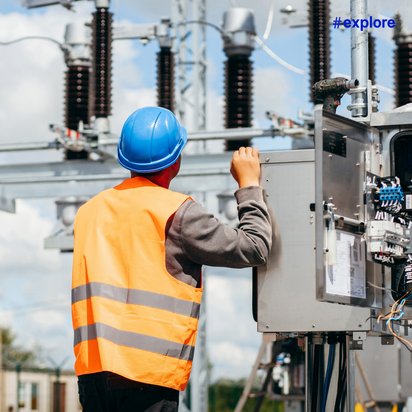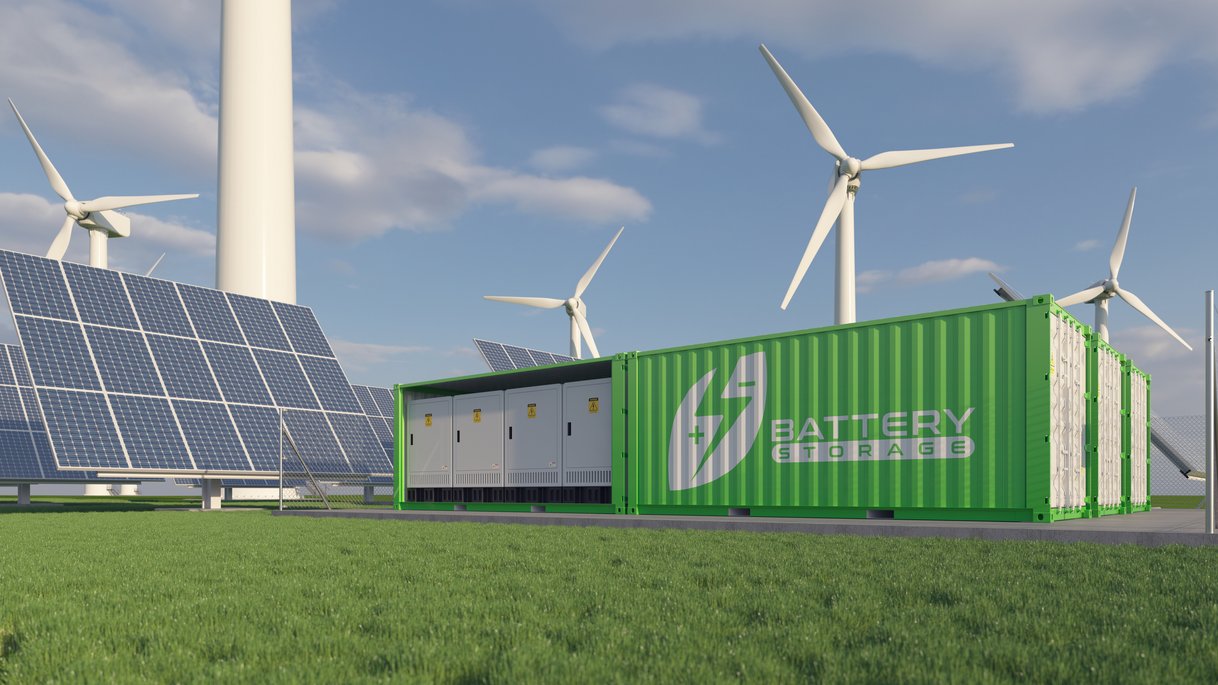Storing electricity
Brought back to life
Can compressed air storage systems play a role in the energy transition?

Storing electricity
Can compressed air storage systems play a role in the energy transition?

4 September 2025
Batteries, pumped-storage power plants and hydrogen storage systems are variously considered the means of choice, both today and for the future, for the storage of renewable electricity – to stabilise the power grids when the sun is not shining and the wind is not blowing. China, however, has rediscovered an old technology: the compressed air reservoir. This article explains how a nearly obsolete storage option has been given a new lease of life.
With its endless arrays of buttons, knobs, flashing lights and measuring devices, anyone who enters the control room of the Huntorf compressed air reservoir for the first time will feel as if they have been beamed onto the bridge of the Starship Enterprise. Taking them back to 1968, when Captain Kirk and Mr. Spock first set out to explore the vast expanses of space. In fact, the compressed air reservoir power plant in Lower Saxony is over ten years younger than the classic series: it was first connected to the grid in 1978 and has been storing electricity at a depth of 650 metres below ground ever since.
When prices fall on the electricity exchanges, it’s a signal for large compressors to start up in Huntorf. These suck in air from the outside, compress it and force it into underground caverns – huge underground cavities. The two caverns under the power plant, which were flushed out of a salt dome, are 50 metres high and 60 metres wide. They have a combined volume of about 310,000 cubic metres – equivalent to the capacity of over 1.7 million bathtubs. When more electricity is needed, and electricity prices rise, the compressed air in the caverns is released and directed over turbines, which in turn drive a generator that produces electricity.
The storage power plant was originally built to absorb nighttime surpluses, for example from the neighboring Unterweser nuclear power plant. In the age of the energy transition, this kind of storage system would be of particular interest for the storage of surplus wind and solar power. And compressed air storage systems do indeed have a lot to offer in this respect: as is the case with pumped-storage power plants, large amounts of energy can be stored in them without loss, even over a longer period. And while pumped storage requires gradients, compressed air storage can also be built in lowland areas – provided that the subterranean geological conditions are right. In Germany, suitable salt caverns exist in the north, in Bavaria and in a broad swathe of land that runs from Hesse to Brandenburg. In principle, as researchers at the University of Heidelberg have calculated, this would be enough to cover over 90 percent of Germany’s annual energy demand.
The fact that Huntorf is still the only compressed air storage power plant in Germany to this day and that, for decades, only one other large plant was operated in the USA, has a lot to do with the physical side effects of the storage process: when you compress air, it heats up, as can be observed with an air pump, for example. Because the air in the Huntorf caverns must not exceed a temperature of 50 degrees for safety reasons, it is first cooled down in several stages. When the air for electricity generation is allowed to expand again, it cools down very rapidly in a way which would freeze the turbines. This is why the air is heated with the help of natural gas before it is directed to the turbine.
Cooling and heating the air therefore uses a lot of energy, which explains why the efficiency of Huntorf is just 42 percent. For comparison, pumped-storage power plants have an efficiency of up to 80 percent, and battery storage systems do even better, managing 95 percent. This low energy efficiency is the reason why the storage reservoir in Huntorf was already on the brink of economic collapse way back in the 1990s. And of course, because it needs natural gas to operate, it is anything but fossil-fuel-free.
To make the process more climate-friendly, operator Uniper is seeking to replace natural gas with green hydrogen in the medium term. The greater fluctuation in electricity prices that has been a feature of the energy transition has allowed Huntorf tio run economically once again. Uniper has increased its storage capacity from 1,200 to 1,680 megawatt hours (MWh). But this old technology has been revived elsewhere: in China, to be precise.
Although China only embraced the technology in the early 2000s, it seems to have caught up quickly, rather like it did with the solar industry and car manufacturing: in 2022, a demonstration storage facility with a capacity of 100 megawatts (MW) was commissioned in the city of Zhangjiakou. The “Nengchu-1” compressed air storage power plant has been in commercial operation in Yingcheng since January 2025. It has an output of 300 MW and can deliver electricity for up to five hours, making a storage capacity of 1,500 MW, which means that it is fast catching up with Huntorf in terms of power and capacity.
But unlike the latter, “Nengchu-1” uses an adiabatic system. In this system, the heat generated during air compression is stored, for example in a huge concrete block or in liquid salt. This heat is then used to return the air to turbine operating temperature later on. There is no need for natural gas. The state-owned China Energy Engineering Group (CEEC), which operates the Chinese compressed air storage facilities, sees market potential, at least in the Middle Kingdom. And so, the adiabatic reservoir in Yingcheng is not intended to be the last of its kind. The groundbreaking ceremony for a plant with a capacity of 700 MW and 2,800 MWh of storage capacity was held in Changzhou at the end of 2024.
Chinese engineers are also working on solutions for places where there is no subterranean salt dome. In Xinyang, a 300 MW project is currently being built with an artificially created storage tunnel carved out of the rock. Once commissioned, the plant is expected to generate 420 million kilowatt hours annually – enough to supply 350,000 households with electricity. Compared to the 2022 pilot plant, CEEC claims that its efficiency has increased by two percent to 72.1 percent and that the cost per kilowatt hour has been reduced by as much as 30 percent.
With continued upscaling and a fully domestic supply chain, the technology could become one of the most cost-effective options for long-term storage in China. The state-owned company is convinced of this and is already thinking about plants with 600 and 1,000 MW.
Whether this expectation will be fulfilled remains to be seen. After all, batteries are also being built on a large scale in China and becoming ever cheaper year on year. But there is no scenario in which compressed air storage can or will replace batteries and pumped-storage power plants; it will at best complement them.
Western companies, too, such as Hydrostor, are increasingly convinced that they can play a role in the storage mix for the energy transition. The Canadian firm has been operating a small demonstration plant with heat storage near Ontario since 2019. Large-scale projects with 200 to 500 MW in Canada, Australia and the US are under development, with two of them at an advanced stage, as Hydrostor points out.
The technology is also to be given a second chance in Germany. Dutch company Corre Energy has teamed up with the energy supplier Eneco and is planning a large compressed air reservoir system with a total capacity of 640 MW in Ahaus, Münsterland. Unlike Hydrostor in Canada and CEEC in China, Corre Energy intends to use natural gas to reheat the air, which will later be replaced by green hydrogen. The heat generated during compression will therefore not be stored but instead be used for district heating, thus enabling an overall efficiency of 65 percent.
In fact, according to calculations by researchers at Clausthal University of Technology, a hydrogen-based compressed air storage system of this kind would be the best and most cost-effective compressed air reservoir concept. If everything goes according to plan, the plant will be ready for operation in 2030 – and the venerable compressed air storage power plant in Huntorf will then get a fairly sizeable and up-to-date sibling after more than half a century.

This is an article from #explore. #explore is a digital journey of discovery into a world that is changing at a rapid pace. Increasing connectivity, innovative technologies, and all-encompassing digitalization are creating new things and turning the familiar upside down. But this also harbors dangers and risks: #explore shows a safe way through the connected world.